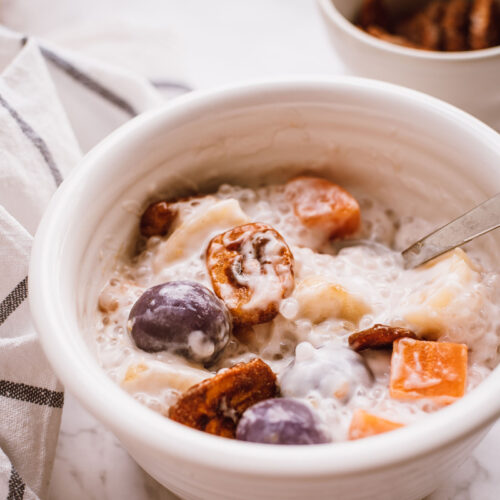Filipino Ginataang Halo-Halo
This snack is made up of bilo-bilo (glutinous rice balls), sliced saba (plantains), sago (tapioca balls), langka (jackfruit), kamote (sweet potatoes) in a creamy coconut sauce. While these are the most common ingredients, it’s not unheard of to add ube (purple yam) or gabi (taro) to the mix.
Ingredients
For the Sago:
- 100 grams sago (tapioca balls), small
- 4 cups water
For the Bilo-bilo:
- 142 grams glutinous rice flour, 1 cup
- 2 tbsps ube powder, optional
- 1/2 cup water
- few drops of ube flavoring, optional
Other Ingredients:
- 2 cups coconut milk
- 1 cup water
- 73 grams sugar, 1/3 cup
- 400 grams sweet potato, diced
- 4 saba (plantain bananas), sliced to 1-in thickness pieces
- 6 pieces jackfruit, cut into strips
For Banana Topping (Optional):
- 2 saba, plantain bananas, sliced thinly
- 55 grams brown sugar, 1/4 cup
- oil for frying
Instructions
To make the sago:
- Bring 4 cups of water to a boil.
- Add the sago, and boil for 10-15 minutes until the sago turns transparent. Stir the sago occasionally to prevent them from sticking to the bottom of the pan. Add more water as needed.
- Once the sago balls are transparent, remove from the heat and drain completely. Put aside in a bowl.
To make the bilo-bilo:
- In a bowl, combine the rice flour and ube powder.
- Mix the water and a few drops of ube flavoring (if using).
- Add the water to the rice flour and mix until it forms into a soft and flexible ball. You can add more drops to the ball for a stronger color but make sure to knead the dough thoroughly to mix the ube flavoring uniformly.
- Divide into 24 balls using a half tablespoon. Set aside and cover with a damp towel.
To make the Ginataang Bilo-bilo:
- In a large pot, mix the coconut milk, water, and sugar. Bring the mixture to a simmer while stirring occasionally to dissolve the sugar.
- Add the sweet potato and boil for 5 minutes. Add the saba and boil for another 3 minutes.
- Add the bilo-bilo and jackfruit strips. Cook until the bilo-bilo floats.
- Mix the sago and stir to prevent lumps from forming. Cook for 5 minutes before removing from heat.
- Serve warm or cold.
To make the saba topping:
- Heat enough oil to deep fry the saba pieces.
- Fry the saba slices until translucent.
- Add the brown sugar to the oil. Swirl the saba slices in the brown sugar until they are coated.
- Remove from the oil and set aside. Cool slightly before using as toppings.
Notes
- Want a deeper purple hue? Add a few extra drops of ube flavoring to your bilo-bilo for a more vibrant color.
- You can skip the ube powder or ube flavoring if you prefer a more traditional take.
- Ginataang bilo-bilo thickens as it cools, so expect a creamier consistency over time.
